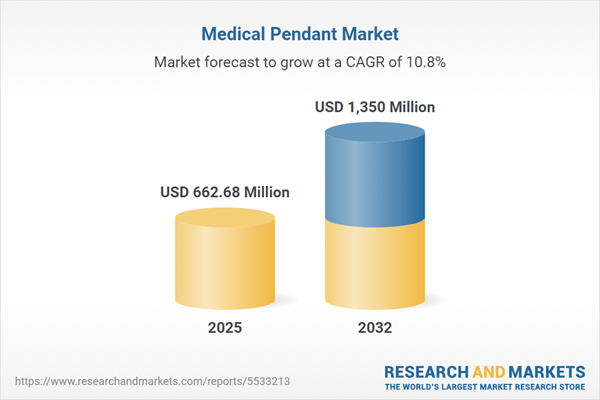Speak directly to the analyst to clarify any post sales queries you may have.
Medical pendant systems are transforming clinical environments by supporting efficient care delivery, enabling adaptable workflows, and meeting the evolving demands of healthcare providers worldwide. Senior leaders focused on optimizing safety, efficiency, and compliance turn to these solutions to future-proof their organizations as patient needs and operational landscapes shift.
Market Snapshot: Medical Pendant Market Size and Growth Outlook
The global medical pendant market is projected to increase from USD 598.71 million in 2024 to USD 662.68 million by 2025, demonstrating a compound annual growth rate (CAGR) of 10.76%. This expansion is driven by heightened investment in healthcare infrastructure, the uptake of digital health policies, and demand for enhanced, technology-powered workflows. Procurement professionals now focus on system compatibility, advanced integration, and scalable system design to support organizational growth, operational efficiency, and resource optimization in dynamic healthcare settings.
Scope & Segmentation in the Medical Pendant Market
Understanding medical pendant market segmentation supports targeted investment, efficient resource allocation, and procurement strategies closely aligned with operational priorities. Careful assessment of each segment enables organizations to select solutions designed for specific environments, improve deployment effectiveness, and foster long-term adaptability.
- Product Type: Includes wired and wireless systems, offering configuration flexibility for hospitals and outpatient facilities through options such as Bluetooth, Wi-Fi, and cellular connectivity.
- End User: Used in hospitals, nursing homes, assisted living centers, and home care settings, each presenting unique operational requirements, staffing challenges, and compliance protocols that influence system selection and implementation.
- Distribution Channel: Features direct sales, distributor partnerships, retail pharmacies, and online platforms, ensuring a range of purchasing strategies suitable for both centralized and decentralized healthcare organizations.
- Technology: Involves Bluetooth, infrared, and radio-frequency solutions, each presenting distinct impacts on compatibility, data protection, and integration with clinical IT systems.
- Region: Covers Americas, Europe, Middle East & Africa, and Asia-Pacific, with each area reflecting different regulatory environments, healthcare infrastructure traditions, and procurement approaches.
- Featured Companies: Principal suppliers such as Getinge AB, Baxter International Inc., Drägerwerk AG & Co. KGaA, STERIS Plc, Amico Corporation, Merivaara Oy, GE HealthCare Inc., InfoPrudent Systems Pvt. Ltd., Bernhard Medical Ltd., and P.E. Associates, Inc. contribute to innovation, regional adoption, and competitive differentiation.
Tailoring strategy to these segments allows organizations to address regional regulatory differences, leverage emerging technology, and maximize clinical impact across diverse care settings.
Key Takeaways for Senior Decision-Makers
- Centralized medical pendant platforms streamline staff workflows, enabling clinicians to focus more on direct patient care rather than device management.
- Wireless systems provide flexibility in facility layouts, simplify cleaning protocols, and support rapid adaptation to regulatory and operational changes.
- Organizations adopting modular system architectures achieve phased upgrades and ensure their investments align with the latest clinical standards and technologies.
- Procurement diversification through multiple channels helps customize purchasing processes and ensures solutions can be efficiently deployed regionally or across multi-site networks.
- Building strong supplier relationships enhances agility in responding to regulatory shifts, supporting ongoing compliance and smooth implementation during market changes.
- Partnerships with manufacturers focused on innovation offer healthcare providers opportunities to quickly advance system performance as needs and benchmarks evolve.
Tariff Impact and Supply Chain Adaptation
Recent U.S. tariff increases are affecting costs for key medical pendant components. Market leaders are managing these changes by localizing manufacturing processes, reinforcing supplier partnerships, and introducing automation to reduce expenses. The use of advanced composite materials and regional sourcing is further improving supply chain resilience, supporting procurement teams as they adapt quickly to shifting regulations and market trends.
Methodology & Data Sources
This report integrates thorough secondary research with direct interviews involving healthcare technology experts, procurement managers, and clinical operations professionals. All findings are validated with regional perspectives to ensure accuracy and relevance for key geographic markets and user segments.
Why This Report Matters for Medical Pendant Market Stakeholders
- Enables organizations to refine procurement tactics and navigate shifts in regulatory environments and industry priorities effectively.
- Equips decision-makers with actionable analysis to support targeted investment, strengthen supply chain reliability, and uphold competitive market positioning.
- Promotes resilience and flexibility as care delivery models and operational demands continue to transform.
Conclusion
Medical pendant solutions provide the strategic flexibility and operational strength required for healthcare organizations to enhance compliance, system reliability, and patient-focused care in a rapidly changing environment.
Additional Product Information:
- Purchase of this report includes 1 year online access with quarterly updates.
- This report can be updated on request. Please contact our Customer Experience team using the Ask a Question widget on our website.
Table of Contents
3. Executive Summary
4. Market Overview
7. Cumulative Impact of Artificial Intelligence 2025
Companies Mentioned
The companies profiled in this Medical Pendant market report include:- Getinge AB
- Baxter International Inc.
- Drägerwerk AG & Co. KGaA
- STERIS Plc
- Amico Corporation
- Merivaara Oy
- GE HealthCare Inc.
- InfoPrudent Systems Pvt. Ltd.
- Bernhard Medical Ltd.
- P.E. Associates, Inc.
Table Information
| Report Attribute | Details |
|---|---|
| No. of Pages | 191 |
| Published | October 2025 |
| Forecast Period | 2025 - 2032 |
| Estimated Market Value ( USD | $ 662.68 Million |
| Forecasted Market Value ( USD | $ 1350 Million |
| Compound Annual Growth Rate | 10.7% |
| Regions Covered | Global |
| No. of Companies Mentioned | 11 |









